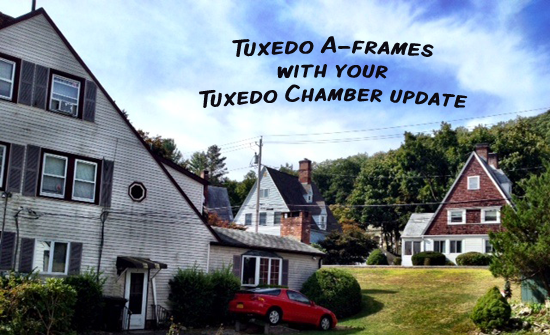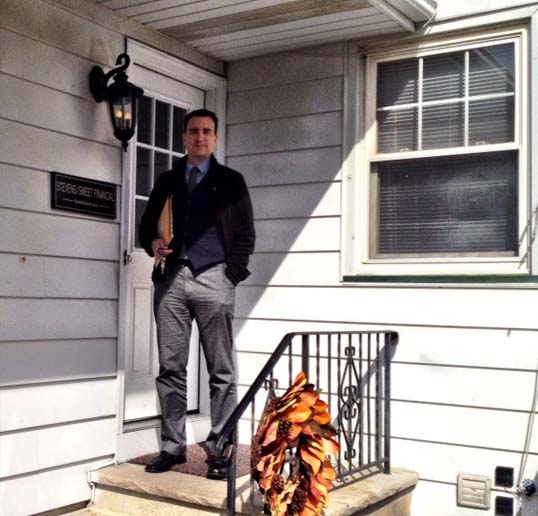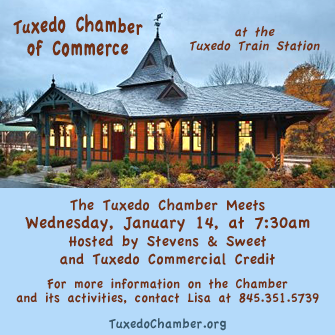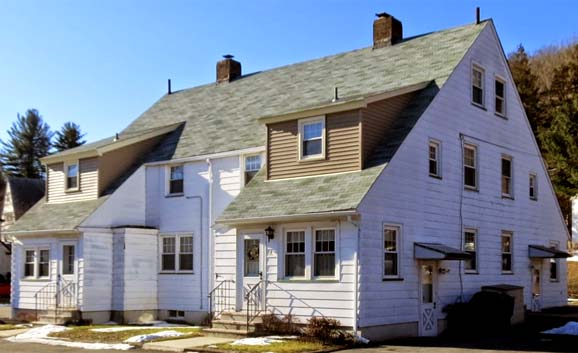
Cottages designed by noted architect Bruce Price dot the hamlet district in downtown Tuxedo.
Traces of Tuxedo’s orginal DNA dot the town along the Rt. 17 corridor, all leading up to Tuxedo Park, of course.
The village that became Tuxedo Park was founded by tobacco tycoon Pierre Lorillard IV as a vacation and recreational outpost for well-heeled New York society too tired to make it up to Newport, RI.

Bill Sweet, president of the Tuxedo Chamber of Commerce, outside the new digs of Stevens and Sweet, which is one of the buildings built by Tuxedo Park architect Bruce Price, who died in Paris in 1903.
Lorillard brought in architect Bruce Price to build the Tuxedo Club and surrounding “cottages.” Price’s Tuxedo structures are noted for their severe stylized A-frame and Shingle Style. According to lore, the Tuxedo Club also famously spawned the Tuxedo dinner jacket itself around the turn of the twentieth century after a summer visit of James Brown Potter and his wife Cora with the Prince of Wales at Sandringham House. The Prince’s tailor copied his preferred style of informal dinner dress for James Potter, who then brought it back to the Tuxedo Club.
 From there, as Club history has it, club members debuted the short men’s dress coat at a bachelor party at the original Delmonico’s in lower Manhattan around 1900. When asked about their short dress coats, which they wore in favor of the established long tailcoat, Tuxedo Club members reportedly said, well, this is what we wear for dinner up in Tuxedo. And the rest is Tuxedo history.
From there, as Club history has it, club members debuted the short men’s dress coat at a bachelor party at the original Delmonico’s in lower Manhattan around 1900. When asked about their short dress coats, which they wore in favor of the established long tailcoat, Tuxedo Club members reportedly said, well, this is what we wear for dinner up in Tuxedo. And the rest is Tuxedo history.
Just before the start of the 20th century, Price apparently built a smattering of simple A-frame cottages in what is now the commercial hamlet area of Tuxedo, just off Rt. 17. Conceived as cottages for people worked up in Tuxedo Park, most of the structures are still in use today as residential housing. Price also built the Tuxedo Post Office and Tuxedo Park Library, which according to Bill Sweet, was designed after Price’s childhood home in Cumberland, Maryland.
Sweet is a partner with lifelong Tuxedo resident Greg Stevens in Stevens and Sweet, a financial services shop that recently moved into one of the largest of the old Price properties, located on aptly-named Store Road. The popular local Tuxedo Barbershop is housed in the Stevens and Sweet building, which also consists of three residential units.

The Stevens and Sweet building was built by Bruce Price in 1900. Price was also the famous father of noted author of American etiquette Emily Post, who inherited four Bruce Price Cottages in Tuxedo Park from her father.
Like much of the Stevens and Sweet building itself, the remaining Price A-frames in the hamlet area of Tuxedo are mostly residential buildings. The cottages are part of the history of Tuxedo and are of a different style from the worker village that grew up in East Tuxedo that housed many of the stone masons and artisans of Italian descent that built the homes of Tuxedo Park.
Bill Sweet, who serves as the Tuxedo Chamber of Commerce president, said that the purchase of the hamlet building was a commitment to the community as much as a business investment. The converted office space provides ample customer parking and helps promote business in the hamlet. Sweet is also a trustee for the Tuxedo Park Library and works closely with the Tuxedo Historical Society.
With Stevens and Sweet gearing up for tax season, which begins January 20th when tax filing for 2014 kicks off, Sweet will be featured speaker at the Tuxedo Chamber’s first meeting of the year Wednesday morning, January 13, at 7:30 a.m. at the Tuxedo Train Station.
The Tuxedo Chamber had a busy 2014, with much of the organization’s time taken up by Genting’s Sterling Forest Resort and Casino bid. The chamber came out in favor of the Genting proposal, primarily due to the consensus that the development might act as an economic engine for Tuxedo and beyond. The conversation started by the Sterling Forest Casino has led to important community dialogue about how to build a vital business district in central district of Tuxedo.
Continuing to grow an active chamber of commerce is one piece of that elusive puzzle.


